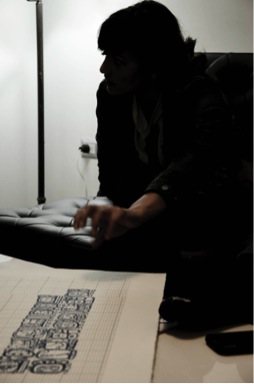EN
Yasmin Hage (Guatemala, 1976) lives and works in Guatemala. She took part in projects such as Octubre Azul, Colloquia, Landings, Image Factory Art Foundation, Contexto (Cinismo, Milenio, Libertad), Lo que hay es lo que hay (DSII), Días Mejores, 2003 (Rosina Cazali), V Bienal del Caribe 2004, 16 Bienal de Arte Paiz 2006 (Nelson Herrera Ysla), “Esbozo para la creación de una sociedad del futuro” 2007, (Laboratorio Curatorial 060) con el proyecto en sitio aldea modelo, pequeña historia,1984, “CulturvaVersusCultura” (Marivi Véliz), “Habitart” y “Campo y Ciudad” (Emiliano Valdés), Ciudad de la Imaginación (Pablo Ramírez), 17 Bienal de Paiz 2010 (José Roca), 8va Bienal Centroamericana (2010), Ultravioleta (bla.bla.bla), The Street Files 2011 (Bienal del Museo del Barrio en Nueva York) y Geopoéticas, Bienal de Mercosur 2011 (José Roca), La Ruleta, Diablo Rosso (Me asusta pero me gusta), Serie Revisiones 2012 (Excéntrico, E. Valdés), Lenguajes Contemporáneos desde Centroamérica (2013, editorial Turner) y Todos tenemos derecho a ser honestos en Espacio Mínimo, Madrid, 2014 (Luisa Fuentes Guaza), la 19 BAP, Transvisible (Cecilia Fajardo Hill). Her work is shown in the collection of the Blanton Museum – Austin, Texas, the Ortiz Gurdián Foundation – León, Nicaragua, Le Plateau – Paris, France, Empresarios por el arte – San José, Costa Rica, Colección APT – México, Colección Quinto-Lojo Guatemala and Colección John Gody, Guatemala.
Statement Yasmin Hage:
“I have a strong relation to drawing which during time slowly transplanted to other forms of art. Through drawing and through the act of representation I acquired a sense of rigorousness, of working on relations, of considering the plane of an art work as a small universe, form and overflow at the same time. Still, my recent work has changed and I now use notions of interchange, orality and negotiation to reconstruct my work with more porous and elastic structures; in some circumstances site specifics and/or in galleries, combining traditional and conceptual languages depending on a new materialization, how it reconfigures after the act, after the document, after the anecdote.”
Visit her project for Guatemala Después, “El olvido que no sabe que es olvido”.
ESP
Yasmin Hage (Guatemala, 1976) vive y trabaja desde Guatemala. Ha sido parte de proyectos como Octubre Azul, Colloquia, Landings, Image Factory Art Foundation, Contexto (Cinismo, Milenio, Libertad), Lo que hay es lo que hay (DSII), Días Mejores, 2003 (Rosina Cazali), V Bienal del Caribe 2004, 16 Bienal de Arte Paiz 2006 (Nelson Herrera Ysla), “Esbozo para la creación de una sociedad del futuro” 2007, (Laboratorio Curatorial 060) con el proyecto en sitio aldea modelo, pequeña historia,1984, “CulturvaVersusCultura” (Marivi Véliz), “Habitart” y “Campo y Ciudad” (Emiliano Valdés), Ciudad de la Imaginación (Pablo Ramírez), 17 Bienal de Paiz 2010 (José Roca), 8va Bienal Centroamericana (2010), Ultravioleta (bla.bla.bla), The Street Files 2011 (Bienal del Museo del Barrio en Nueva York) y Geopoéticas, Bienal de Mercosur 2011 (José Roca), La Ruleta, Diablo Rosso (Me asusta pero me gusta), Serie Revisiones 2012 (Excéntrico, E. Valdés), Lenguajes Contemporáneos desde Centroamérica (2013, editorial Turner) y Todos tenemos derecho a ser honestos en Espacio Mínimo, Madrid, 2014 (Luisa Fuentes Guaza), la 19 BAP, Transvisible (Cecilia Fajardo Hill). Está en las colecciones del Museo Blanton – Austin Texas, Fundación Ortiz Gurdián – León Nicaragua, Le Plateau – París Francia, Empresarios por el arte – San José Costa Rica, Colección APT – México, Colección Quinto-Lojo Guatemala y Colección John Gody, Guatemala. www.serierevisiones.com/yasminhage
Statement Yasmin Hage:
“Tengo una fuerte relación con el dibujo que con el tiempo ha ido trasplantándose hacia otras formas a partir del arte. El sentido de rigor, de ejercer relaciones, de considerar el plano de la obra como un pequeño universo a la vez contenido y desbordado, lo he adquirido del dibujo y del acto de la representación, sin embargo mi trabajo más reciente ha ido migrando y he utilizado el intercambio, la oralidad y la negociación para reconstituir mi obra con estructuras más porosas y elásticas, en circunstancias sitio específicas y/o de sala, combinando lenguajes tradicionales y conceptuales en función de la nueva materialización, y cómo vuelve a reconfigurarse después del hecho, después del documento, después de la anécdota.”
Visita su proyecto en Guatemala Después, “El olvido que no sabe que es olvido”.
